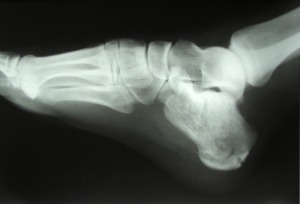
Calcaneus Fracture X-ray (Source: Wikimedia Commons, uploaded by Jojo)
Today I'm beginning a series of posts on the role of nutrition in preventing and recovering from bone fracture. I'll be focusing on the evidence-based literature and the best practice recommendations we can draw from it.
This post summarizes three recent reviews (meta-analyses) on vitamin D and fracture/fall prevention. It also includes a rapid response to the third review article. You may want to read the rapid response first (see end of post) to help your critical appraisal of the three review articles.
-------------------------------------------------------------------------------------------------------------------------------
Review #1:
Source - Cochrane Database of Systematic Reviews. 3, 2009.
Title - Vitamin D and vitamin D analogues for preventing fractures associated with involutional and post-menopausal osteoporosis.
Authors - Avenell, Alison; Gillespie, William J; Gillespie, Lesley D; O'Connell, Dianne
Abstract -
Objectives -To determine the effects of vitamin D or related compounds, with or without calcium, for preventing fractures in older people.
Search strategy - We searched the Cochrane Bone, Joint and Muscle Trauma Group Specialised Register, the Cochrane Central Register of Controlled Trials ( 2007, Issue 3), MEDLINE, EMBASE, CINAHL, and reference lists of articles. Most recent search: October 2007.
Selection criteria - Randomised or quasi-randomised trials comparing vitamin D or related compounds, alone or with calcium, against placebo, no intervention, or calcium alone, reporting fracture outcomes in older people.
Data collection and analysis - Two authors independently assessed trial quality, and extracted data. Data were pooled, where admissible, using the fixed-effect model, or random-effects model if heterogeneity between studies appeared high.
Main results -
Forty-five trials were included.
Vitamin D alone appears unlikely to be effective in preventing hip fracture (nine trials, 24,749 participants, RR 1.15, 95% CI 0.99 to 1.33), vertebral fracture (five trials, 9138 participants, RR 0.90, 95% CI 0.42 to 1.92) or any new fracture (10 trials, 25,016 participants, RR 1.01, 95% CI 0.93 to 1.09).
Vitamin D with calcium reduces hip fractures (eight trials, 46,658 participants, RR 0.84, 95% CI 0.73 to 0.96). Although subgroup analysis by residential status showed a significant reduction in hip fractures in people in institutional care, the difference between this and the community-dwelling subgroup was not significant (P = 0.15).
Overall hypercalcaemia is significantly more common in people receiving vitamin D or an analogue, with or without calcium (18 trials, 11,346 participants, RR 2.35, 95% CI 1.59 to 3.47); this is especially true of calcitriol (four trials, 988 participants, RR 4.41, 95% CI 2.14 to 9.09). There is a modest increase in gastrointestinal symptoms (11 trials, 47,042 participants, RR 1.04, 95% CI 1.00 to 1.08, P = 0.04) and a small but significant increase in renal disease (11 trials, 46,537 participants, RR 1.16, 95% CI 1.02 to 1.33).
Authors' conclusions -
- Frail older people confined to institutions may sustain fewer hip fractures if given vitamin D with calcium.
- Vitamin D alone is unlikely to prevent fracture.
- Overall there is a small but significant increase in gastrointestinal symptoms and renal disease associated with vitamin D or its analogues.
- Calcitriol is associated with an increased incidence of hypercalcaemia.
Links:
Abstract & plain language summary
Full article (PDF, 1.17 MB)
-------------------------------------------------------------------------------------------------------------------------------
Review #2:
Source - Cochrane Database of Systematic Reviews. 3, 2009
Title - Interventions for preventing falls in older people living in the community.
Authors - Gillespie, Lesley D; Robertson, M Clare; Gillespie, William J; Lamb, Sarah E; Gates, Simon; Cumming, Robert G; Rowe, Brian H
Abstract -
Objectives - To assess the effects of interventions to reduce the incidence of falls in older people living in the community.
Search strategy - We searched the Cochrane Bone, Joint and Muscle Trauma Group Specialised Register, CENTRAL ( 2008, Issue 2), MEDLINE, EMBASE, CINAHL, and Current Controlled Trials (all to May 2008).
Selection criteria - Randomised trials of interventions to reduce falls in community-dwelling older people. Primary outcomes were rate of falls and risk of falling.
Data collection and analysis - Two review authors independently assessed trial quality and extracted data. Data were pooled where appropriate.
Main results
We included 111 trials (55,303 participants).
Multiple-component group exercise reduced rate of falls and risk of falling (rate ratio (RaR) 0.78, 95%CI 0.71 to 0.86; risk ratio (RR) 0.83, 95%CI 0.72 to 0.97), as did Tai Chi (RaR 0.63, 95%CI 0.52 to 0.78; RR 0.65, 95%CI 0.51 to 0.82), and individually prescribed multiple-component home-based exercise (RaR 0.66, 95%CI 0.53 to 0.82; RR 0.77, 95%CI 0.61 to 0.97).
Assessment and multifactorial intervention reduced rate of falls (RaR 0.75, 95%CI 0.65 to 0.86), but not risk of falling.
Overall, vitamin D did not reduce falls (RaR 0.95, 95%CI 0.80 to 1.14; RR 0.96, 95%CI 0.92 to 1.01), but may do so in people with lower vitamin D levels. [Bolding added for emphasis.]
Overall, home safety interventions did not reduce falls (RaR 0.90, 95%CI 0.79 to 1.03; RR 0.89, 95%CI 0.80 to 1.00), but were effective in people with severe visual impairment, and in others at higher risk of falling. An anti-slip shoe device reduced rate of falls in icy conditions (RaR 0.42, 95%CI 0.22 to 0.78).
Gradual withdrawal of psychotropic medication reduced rate of falls (RaR 0.34, 95%CI 0.16 to 0.73), but not risk of falling. A prescribing modification programme for primary care physicians significantly reduced risk of falling (RR 0.61, 95%CI 0.41 to 0.91).
Pacemakers reduced rate of falls in people with carotid sinus hypersensitivity (RaR 0.42, 95%CI 0.23 to 0.75). First eye cataract surgery reduced rate of falls (RaR 0.66, 95%CI 0.45 to 0.95).
There is some evidence that falls prevention strategies can be cost saving.
Authors' conclusions -
- Exercise interventions reduce risk and rate of falls.
- Research is needed to confirm the contexts in which multifactorial assessment and intervention, home safety interventions, vitamin D supplementation, and other interventions are effective.
Links
Abstract & plain language summary
Full article (PDF, 2.54 MB)
-------------------------------------------------------------------------------------------------------------------------------
Review #3:
Source - BMJ 2009;339:b3692, doi: 10.1136/bmj.b3692 (Published 1 October 2009)
Title - Fall prevention with supplemental and active forms of vitamin D: a meta-analysis of randomised controlled trials
Authors - Bischoff-Ferrari, HA; Dawson-Hughes, B; Staehelin, HB; Orav, JE; Stuck, AE; Theiler, R; Wong, J B; Egli, A; Kiel, DP; Henschkowski, J.
Abstract -
Objective - To test the efficacy of supplemental vitamin D and active forms of vitamin D with or without calcium in preventing falls among older individuals.
Data sources - We searched Medline, the Cochrane central register of controlled trials, BIOSIS, and Embase up to August 2008 for relevant articles. Further studies were identified by consulting clinical experts, bibliographies, and abstracts. We contacted authors for additional data when necessary.
Review methods - Only double blind randomised controlled trials of older individuals (mean age 65 years or older) receiving a defined oral dose of supplemental vitamin D (vitamin D3 (cholecalciferol) or vitamin D2 (ergocalciferol)) or an active form of vitamin D (1 -hydroxyvitamin D3 (1
-hydroxyvitamin D3 (1 -hydroxycalciferol) or 1,25-dihydroxyvitamin D3 (1,25-dihydroxycholecalciferol)) and with sufficiently specified fall assessment were considered for inclusion.
-hydroxycalciferol) or 1,25-dihydroxyvitamin D3 (1,25-dihydroxycholecalciferol)) and with sufficiently specified fall assessment were considered for inclusion.
Results - Eight randomised controlled trials (n=2426) of supplemental vitamin D met our inclusion criteria. Heterogeneity among trials was observed for dose of vitamin D (700-1000 IU/day v 200-600 IU/day; P=0.02) and achieved 25-hydroxyvitamin D3 concentration (25(OH)D concentration: <60 nmol/l v  60 nmol/l; P=0.005). High dose supplemental vitamin D reduced fall risk by 19% (pooled relative risk (RR) 0.81, 95% CI 0.71 to 0.92; n=1921 from seven trials), whereas achieved serum 25(OH)D concentrations of 60 nmol/l or more resulted in a 23% fall reduction (pooled RR 0.77, 95% CI 0.65 to 0.90). Falls were not notably reduced by low dose supplemental vitamin D (pooled RR 1.10, 95% CI 0.89 to 1.35; n=505 from two trials) or by achieved serum 25-hydroxyvitamin D concentrations of less than 60 nmol/l (pooled RR 1.35, 95% CI 0.98 to 1.84). Two randomised controlled trials (n=624) of active forms of vitamin D met our inclusion criteria. Active forms of vitamin D reduced fall risk by 22% (pooled RR 0.78, 95% CI 0.64 to 0.94).
60 nmol/l; P=0.005). High dose supplemental vitamin D reduced fall risk by 19% (pooled relative risk (RR) 0.81, 95% CI 0.71 to 0.92; n=1921 from seven trials), whereas achieved serum 25(OH)D concentrations of 60 nmol/l or more resulted in a 23% fall reduction (pooled RR 0.77, 95% CI 0.65 to 0.90). Falls were not notably reduced by low dose supplemental vitamin D (pooled RR 1.10, 95% CI 0.89 to 1.35; n=505 from two trials) or by achieved serum 25-hydroxyvitamin D concentrations of less than 60 nmol/l (pooled RR 1.35, 95% CI 0.98 to 1.84). Two randomised controlled trials (n=624) of active forms of vitamin D met our inclusion criteria. Active forms of vitamin D reduced fall risk by 22% (pooled RR 0.78, 95% CI 0.64 to 0.94).
Conclusions - Supplemental vitamin D in a dose of 700-1000 IU a day reduced the risk of falling among older individuals by 19% and to a similar degree as active forms of vitamin D. Doses of supplemental vitamin D of less than 700 IU or serum 25-hydroxyvitamin D concentrations of less than 60 nmol/l may not reduce the risk of falling among older individuals.
Links:
Abstract and data supplement (trials included in meta-analysis).
Full article (PDF).
Rapid response to this article: Time for a moratorium on meta-analyses of vitamin D?
-------------------------------------------------------------------------------------------------------------------------------
 Thursday, January 21, 2010
Thursday, January 21, 2010  4 Comments | |
4 Comments | |  Permalink | tagged
Permalink | tagged  Glycemic Index,
Glycemic Index,  Resource round-up,
Resource round-up,  bone health,
bone health,  carbohydrate,
carbohydrate,  mental health,
mental health,  tube feeding
tube feeding 


 -hydroxyvitamin D3 (1
-hydroxyvitamin D3 (1 60 nmol/l; P=0.005). High dose supplemental vitamin D reduced fall risk by 19% (pooled relative risk (RR) 0.81, 95% CI 0.71 to 0.92; n=1921 from seven trials), whereas achieved serum 25(OH)D concentrations of 60 nmol/l or more resulted in a 23% fall reduction (pooled RR 0.77, 95% CI 0.65 to 0.90). Falls were not notably reduced by low dose supplemental vitamin D (pooled RR 1.10, 95% CI 0.89 to 1.35; n=505 from two trials) or by achieved serum 25-hydroxyvitamin D concentrations of less than 60 nmol/l (pooled RR 1.35, 95% CI 0.98 to 1.84). Two randomised controlled trials (n=624) of active forms of vitamin D met our inclusion criteria. Active forms of vitamin D reduced fall risk by 22% (pooled RR 0.78, 95% CI 0.64 to 0.94).
60 nmol/l; P=0.005). High dose supplemental vitamin D reduced fall risk by 19% (pooled relative risk (RR) 0.81, 95% CI 0.71 to 0.92; n=1921 from seven trials), whereas achieved serum 25(OH)D concentrations of 60 nmol/l or more resulted in a 23% fall reduction (pooled RR 0.77, 95% CI 0.65 to 0.90). Falls were not notably reduced by low dose supplemental vitamin D (pooled RR 1.10, 95% CI 0.89 to 1.35; n=505 from two trials) or by achieved serum 25-hydroxyvitamin D concentrations of less than 60 nmol/l (pooled RR 1.35, 95% CI 0.98 to 1.84). Two randomised controlled trials (n=624) of active forms of vitamin D met our inclusion criteria. Active forms of vitamin D reduced fall risk by 22% (pooled RR 0.78, 95% CI 0.64 to 0.94).